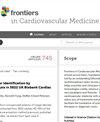Differences in cardiovascular risk factors associated with sex and gender identity, but not gender expression, in young, healthy cisgender adults
IF 2.8
3区 医学
Q2 CARDIAC & CARDIOVASCULAR SYSTEMS
引用次数: 0
Abstract
BackgroundSex differences exist in cardiovascular disease risk factors including elevated blood pressure and arterial stiffness, and decreased endothelial function in males compared to females. Feminine gender expression may be associated with elevated risk of acute coronary syndrome. However, no study has investigated the associations between sex, gender identity, and gender expression and cardiovascular disease risk factors in young adults.MethodsOne hundred and thirty participants (22 ± 3 years) underwent assessments of hemodynamics, arterial stiffness [pulse wave velocity (PWV)], and brachial artery endothelial function (flow-mediated dilation; %FMD). Participants completed a questionnaire capturing sex category (50 male/80 female), gender identity category (49 men/79 women/2 non-binary), and aspects of gender expression assessed by the Bem Sex Role Inventory-30 (39 androgynous/33 feminine/29 masculine/29 undifferentiated). Sex/gender identity category groups were compared using unpaired年轻、健康的同性成年人心血管风险因素与性别和性别认同的差异,而与性别表达无关
背景与女性相比,男性在心血管疾病风险因素方面存在性别差异,包括血压升高、动脉僵化以及内皮功能下降。女性的性别表达可能与急性冠状动脉综合征的风险升高有关。方法 130 名参与者(22 ± 3 岁)接受了血液动力学、动脉僵化[脉搏波速度(PWV)]和肱动脉内皮功能(血流介导的扩张;%FMD)评估。参与者填写了一份调查问卷,其中包括性别类别(50 名男性/80 名女性)、性别认同类别(49 名男性/79 名女性/2 名非二元),以及由 Bem Sex Role Inventory-30 评估的性别表达方面(39 名雌雄同体者/33 名女性/29 名男性/29 名未分化者)。性别/性别认同类别组之间的比较采用非配对 t 检验,性别表达组之间的比较采用单因素方差分析。男性的中心脉搏波速度升高[中位数(四分位间范围):6.4 (1.8) vs. 5.8 (2.2) m/s,p = 0.02];然而,腿部和手臂的脉搏波速度在性别之间没有差异。在考虑到男性基线动脉直径更大(8.8 ± 3.3% vs. 7.2 ± 3.1%,p = 0.02)的情况下,男性的 FMD 百分比高于女性;由于大多数参与者都是顺性性别,因此对性别认同(男性 vs. 女性)的研究结果相同。结论性别/性别认同类别(而非性别表达)对顺性别成年人的心血管风险因素(血压、动脉僵化、内皮功能)有影响;需要在性别多样化人群中开展进一步研究。
本文章由计算机程序翻译,如有差异,请以英文原文为准。
求助全文
约1分钟内获得全文
求助全文
来源期刊

Frontiers in Cardiovascular Medicine
Medicine-Cardiology and Cardiovascular Medicine
CiteScore
3.80
自引率
11.10%
发文量
3529
审稿时长
14 weeks
期刊介绍:
Frontiers? Which frontiers? Where exactly are the frontiers of cardiovascular medicine? And who should be defining these frontiers?
At Frontiers in Cardiovascular Medicine we believe it is worth being curious to foresee and explore beyond the current frontiers. In other words, we would like, through the articles published by our community journal Frontiers in Cardiovascular Medicine, to anticipate the future of cardiovascular medicine, and thus better prevent cardiovascular disorders and improve therapeutic options and outcomes of our patients.
文献相关原料
| 公司名称 | 产品信息 | 采购帮参考价格 |
|---|
 求助内容:
求助内容: 应助结果提醒方式:
应助结果提醒方式:


